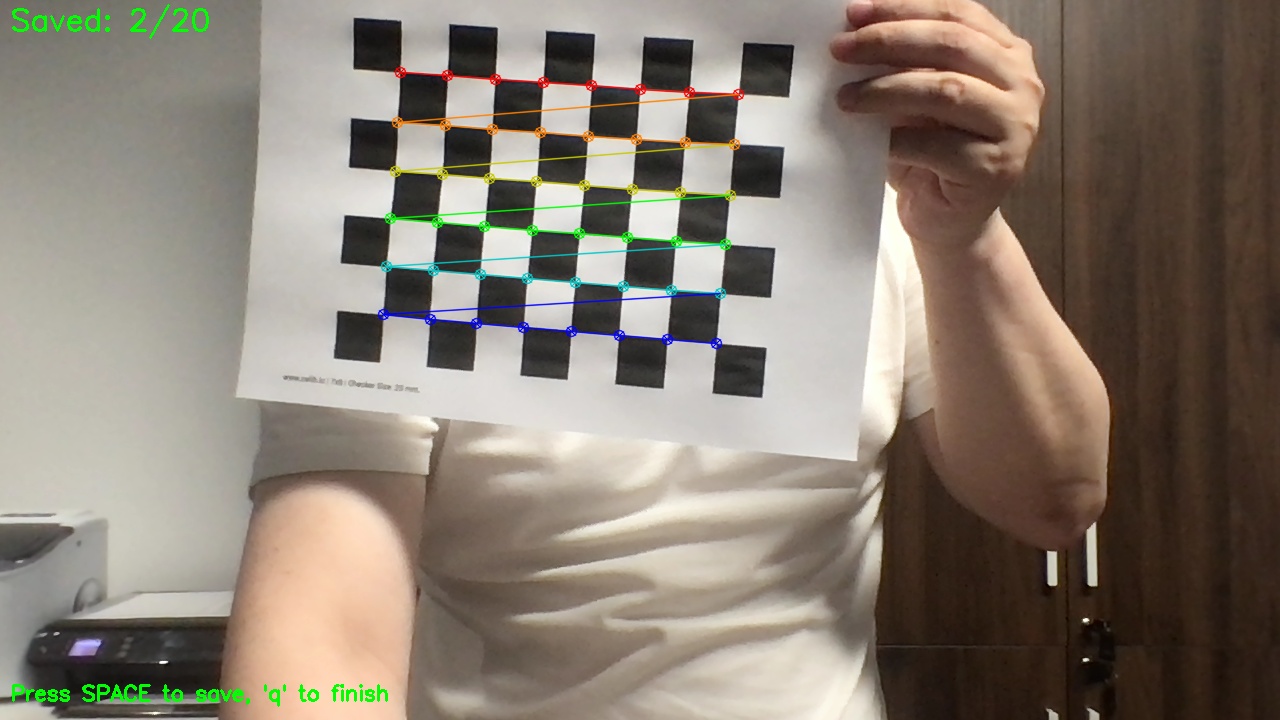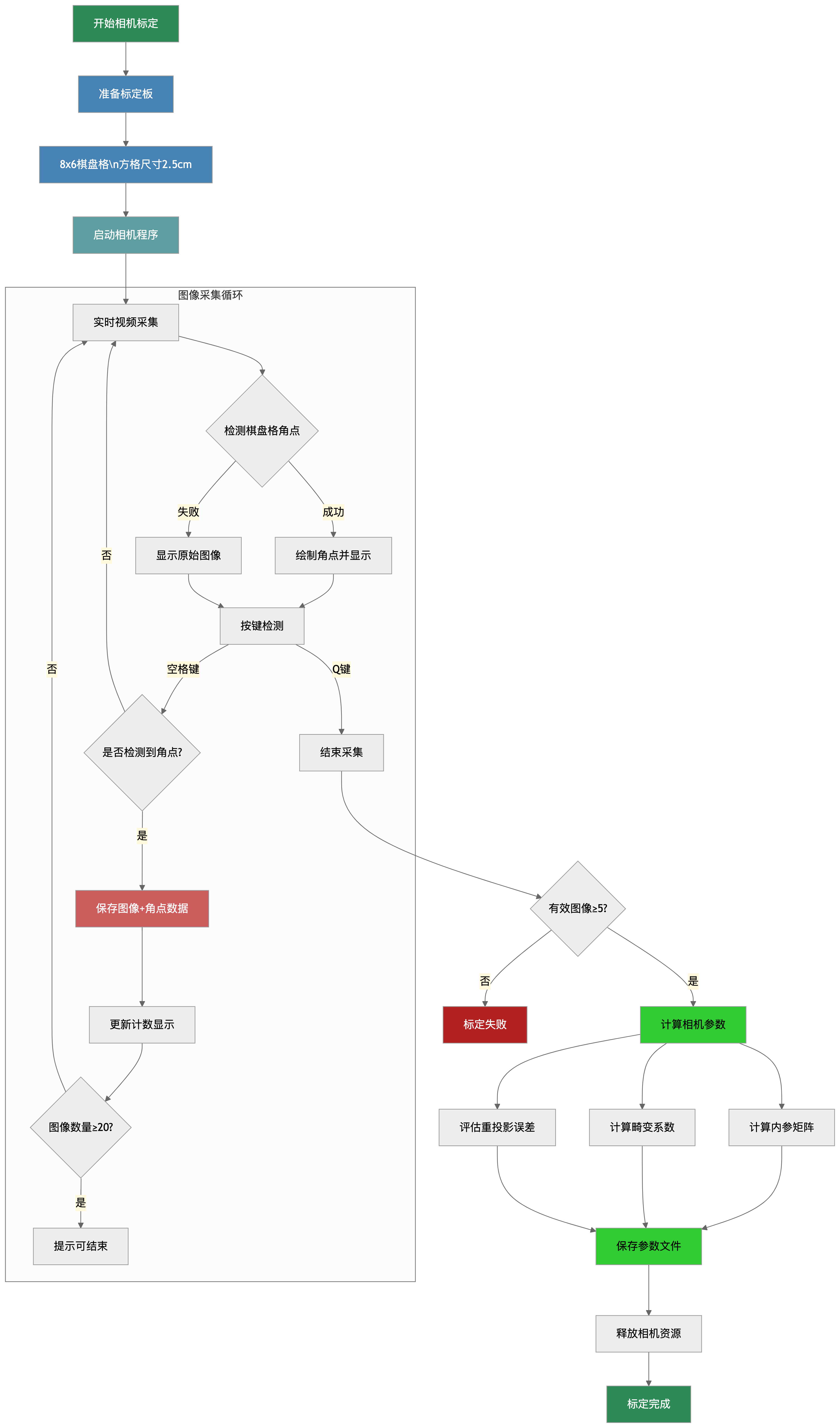相机标定实战(棋盘标定法):从原理到实践
原创为什么需要相机标定?
在计算机视觉中,真实世界的3D点需要映射到2D图像平面上。这个过程受镜头畸变和相机内部参数影响。相机标定就是确定这些参数的过程,它能:
- 消除镜头畸变(鱼眼、桶形失真等)
- 获取物体真实尺寸(从像素到实际距离)
- 实现精确的3D重建和姿态估计
相机标定原理
标定的核心是棋盘格标定板,其规则图案提供了已知的3D空间坐标点:
- 对象点:棋盘格角点的3D坐标(X, Y, Z)
- 图像点:棋盘格在图像中的2D角点位置
- 相机模型:通过求解投影方程确定:
- 内参矩阵(焦距、主点坐标)
- 畸变系数(径向、切向畸变)
标定工具使用指南
准备工作
- 打印8x6棋盘格(每个方格2.5x2.5cm),这里的8x6是黑白交汇点的数量,若计算黑白格子,则为9x7
- 固定相机位置(避免中途移动)
- 准备不同角度和距离的拍摄位置
操作步骤
python3 calibrate_camera.py
标定过程的场景实际截图
上图中使用的是打印的棋盘格,既不平整又不防止反光和漫射,仅供演示。
- 运行程序启动相机
- 将棋盘格置于不同位置(倾斜/旋转/远近)
- 按空格键保存有效帧(棋盘格需完整显示)
- 收集15-20张图像后按'q'键结束
- 程序自动计算并保存参数到
camera_params.npz
标定结果包含:内参矩阵(3x3) 畸变系数(k1, k2, p1, p2, k3) 重投影误差(评估标定质量)

标定流程图
代码解析
核心类CameraCalibrator实现标定全流程:
# 角点检测(关键步骤)
gray = cv2.cvtColor(img, cv2.COLOR_BGR2GRAY)
ret, corners = cv2.findChessboardCorners(gray, self.board_size, None)
# 亚像素优化(提高精度)
corners2 = cv2.cornerSubPix(gray, corners, (11,11), (-1,-1), self.criteria)
# 标定计算
ret, mtx, dist, _, _ = cv2.calibrateCamera(
self.objpoints, self.imgpoints, img_size, None, None
)
# 重投影误差评估
imgpoints2, _ = cv2.projectPoints(objpoints, rvecs, tvecs, mtx, dist)
error = cv2.norm(imgpoints, imgpoints2, cv2.NORM_L2)/len(imgpoints2)实际应用技巧
- 棋盘格要求:
- 使用哑光材质避免反光
- 保持棋盘格平整无褶皱
- 方格尺寸需精确测量
- 拍摄技巧:
- 覆盖图像不同区域(中心/边缘)
- 包含各种旋转角度(±30°以上)
- 近/中/远距离都要覆盖
- 质量评估:
- 重投影误差<0.5像素为优秀
- 误差>1像素需重新标定
- 检查边缘区域的畸变校正效果
标定结果应用
获取参数后,可轻松校正新图像:
params = np.load("camera_params.npz")
mtx = params['camera_matrix']
dist = params['dist_coeffs']
# 畸变校正
undistorted = cv2.undistort(image, mtx, dist)结语
精确的相机标定是计算机视觉应用的基石。本文提供的工具简化了标定流程,结合实践技巧,可实现毫米级精度的测量任务。标定后,您将获得更准确的AR导航、三维重建和工业检测结果。
源码获取:
"""
相机标定工具
使用说明:
1. 打印一个棋盘格标定板(推荐使用8x6的棋盘格,每个方格的尺寸为2.5cm x 2.5cm)
2. 将标定板放在不同位置和角度,让程序采集多张图片(建议15-20张)
3. 按空格键保存当前帧,按'q'键完成标定
"""
import cv2
import numpy as np
import os
from datetime import datetime
from typing import Optional, Tuple
class CameraCalibrator:
def __init__(self, board_size=(8, 6), square_size=0.025):
"""
初始化相机标定器
参数:
board_size: 棋盘格内部角点数量 (width, height)
square_size: 每个方格的实际大小(单位:米)
"""
self.board_size = board_size
self.square_size = square_size
self.criteria = (cv2.TERM_CRITERIA_EPS + cv2.TERM_CRITERIA_MAX_ITER, 30, 0.001)
# 准备对象点,如 (0,0,0), (1,0,0), (2,0,0) ....,(8,5,0)
self.objp = np.zeros((board_size[0] * board_size[1], 3), np.float32)
self.objp[:, :2] = np.mgrid[0:board_size[0], 0:board_size[1]].T.reshape(-1, 2) * square_size
# 存储对象点和图像点的数组
self.objpoints = [] # 3D点(世界坐标系)
self.imgpoints = [] # 2D点(图像平面)
# 创建保存标定图像的目录
self.calib_dir = "calibration_images"
os.makedirs(self.calib_dir, exist_ok=True)
def find_corners(self, img: np.ndarray) -> tuple[bool, Optional[np.ndarray]]:
"""
在图像中查找并优化棋盘格角点位置
参数:
img: 输入的BGR彩色图像,形状为(H, W, 3)
返回:
tuple[bool, Optional[np.ndarray]]:
- 第一个元素(bool): 是否成功检测到棋盘格角点
- 第二个元素: 如果检测成功,返回优化后的角点坐标数组,形状为(N, 1, 2),
其中N是角点数量;如果检测失败,返回None
"""
gray = cv2.cvtColor(img, cv2.COLOR_BGR2GRAY)
ret, corners = cv2.findChessboardCorners(gray, self.board_size, None)
if ret:
# 提高角点检测精度
corners2 = cv2.cornerSubPix(
gray, corners, (11, 11), (-1, -1),
(cv2.TERM_CRITERIA_EPS + cv2.TERM_CRITERIA_MAX_ITER, 30, 0.001)
)
return True, corners2
return False, None
def add_calibration_image(self, img: np.ndarray, corners: np.ndarray) -> None:
"""
添加标定图像及其角点数据到标定数据集
参数:
img: 包含棋盘格的BGR彩色图像,形状为(H, W, 3)
corners: 检测到的棋盘格角点坐标数组,形状为(N, 1, 2),
其中N是角点数量,通常为board_size[0] * board_size[1]
返回:
None
副作用:
- 将3D对象点(self.objp)添加到objpoints列表
- 将2D图像点(corners)添加到imgpoints列表
- 将图像保存到calibration_images目录下
"""
self.objpoints.append(self.objp)
self.imgpoints.append(corners)
# 保存标定图像
timestamp = datetime.now().strftime("%Y%m%d_%H%M%S")
filename = os.path.join(self.calib_dir, f"calib_{timestamp}.jpg")
cv2.imwrite(filename, img)
print(f"已保存标定图像: {filename}")
def calibrate(self, img_size: tuple[int, int]) -> tuple[Optional[np.ndarray], Optional[np.ndarray], Optional[float]]:
"""
执行相机标定计算
参数:
img_size: 图像尺寸,格式为(宽度, 高度)
返回:
tuple: 包含三个元素的元组:
- camera_matrix (np.ndarray | None): 3x3相机内参矩阵,格式为:
[[fx, 0, cx],
[0, fy, cy],
[0, 0, 1]]
其中(fx, fy)是焦距,(cx, cy)是主点坐标
- dist_coeffs (np.ndarray | None): 畸变系数,格式为[k1, k2, p1, p2, k3, ...]
- k1, k2, k3: 径向畸变系数
- p1, p2: 切向畸变系数
- mean_error (float | None): 平均重投影误差(像素)
如果标定失败(如图像数量不足),则返回(None, None, None)
"""
if len(self.objpoints) < 5:
print("错误:需要至少5张标定图像")
return None, None, None
ret, mtx, dist, rvecs, tvecs = cv2.calibrateCamera(
self.objpoints, self.imgpoints, img_size, None, None
)
# 计算重投影误差
mean_error = 0.0
for i in range(len(self.objpoints)):
imgpoints2, _ = cv2.projectPoints(
self.objpoints[i], rvecs[i], tvecs[i], mtx, dist
)
error = cv2.norm(self.imgpoints[i], imgpoints2, cv2.NORM_L2) / len(imgpoints2)
mean_error += error
mean_error /= len(self.objpoints)
print(f"重投影误差: {mean_error:.8f} 像素")
print("\n相机内参矩阵:")
print(mtx)
print("\n畸变系数 (k1, k2, p1, p2, k3, ...):")
print(dist[0])
return mtx, dist[0], mean_error
def main():
# 初始化标定器 (8x6 棋盘格,每个方格2.5cm x 2.5cm)
calibrator = CameraCalibrator(board_size=(8, 6), square_size=0.025)
# 打开相机 (0 通常是内置摄像头)
cap = cv2.VideoCapture(0)
cap.set(cv2.CAP_PROP_FRAME_WIDTH, 1280)
cap.set(cv2.CAP_PROP_FRAME_HEIGHT, 720)
print("\n相机标定程序")
print("1. 准备一个8x6的棋盘格标定板")
print("2. 将棋盘格放在相机前不同位置和角度")
print("3. 按空格键保存当前帧,按'q'键完成标定")
print("4. 建议保存15-20张不同角度的图像")
while True:
ret, frame = cap.read()
if not ret:
print("无法获取相机画面")
break
# 查找棋盘格角点
ret_corners, corners = calibrator.find_corners(frame)
# 如果找到角点,绘制出来
if ret_corners:
cv2.drawChessboardCorners(frame, calibrator.board_size, corners, ret_corners)
# 显示已保存的图像数量
cv2.putText(frame, f"Saved: {len(calibrator.objpoints)}/20",
(10, 30), cv2.FONT_HERSHEY_SIMPLEX, 1, (0, 255, 0), 2)
# Display help text
cv2.putText(frame, "Press SPACE to save, 'q' to finish",
(10, frame.shape[0] - 20),
cv2.FONT_HERSHEY_SIMPLEX, 0.7, (0, 255, 0), 2)
cv2.imshow("Camera Calibration (SPACE to save, 'q' to finish)", frame)
key = cv2.waitKey(1) & 0xFF
if key == ord(' '): # 空格键保存当前帧
if ret_corners:
calibrator.add_calibration_image(frame.copy(), corners)
if len(calibrator.objpoints) >= 20:
print("已保存20张图像,可以按'q'键完成标定")
else:
print("未检测到完整的棋盘格,请调整位置后重试")
elif key == ord('q'): # 'q'键退出
break
# 执行标定
if len(calibrator.objpoints) >= 5:
print("\n正在计算相机参数...")
mtx, dist, error = calibrator.calibrate((frame.shape[1], frame.shape[0]))
if mtx is not None:
# 保存相机参数到文件
np.savez("camera_params.npz",
camera_matrix=mtx,
dist_coeffs=dist,
reprojection_error=error)
print("\n相机参数已保存到 camera_params.npz")
# 释放资源
cap.release()
cv2.destroyAllWindows()
print("\n标定完成!")
if __name__ == "__main__":
main()原创声明:本文系作者授权腾讯云开发者社区发表,未经许可,不得转载。
如有侵权,请联系 cloudcommunity@tencent.com 删除。
原创声明:本文系作者授权腾讯云开发者社区发表,未经许可,不得转载。
如有侵权,请联系 cloudcommunity@tencent.com 删除。
评论
登录后参与评论
推荐阅读
目录


